#structural material estimating
Explore tagged Tumblr posts
Text
Construction Cost Estimating Service for Residential vs. Commercial Projects
Construction cost estimating is an essential process in both residential and commercial projects. While the fundamental principles remain the same, the complexity, scope, and requirements of each type of project differ significantly. Understanding these differences is crucial for contractors, developers, and investors who rely on cost estimating services to create accurate budgets, minimize risks, and ensure project success. This article explores the key distinctions between residential and commercial construction cost estimating services.
Understanding Residential Construction Cost Estimating
Residential construction includes single-family homes, townhouses, duplexes, and multi-unit housing projects. Estimating costs for residential projects involves analyzing materials, labor, permits, and other expenses specific to homebuilding.
Key Factors in Residential Cost Estimating
Material Costs – Residential construction typically uses wood framing, standard-grade materials, and pre-designed components, making cost estimation more predictable.
Labor Costs – Smaller teams and subcontractors handle most residential projects, resulting in simpler workforce calculations.
Project Complexity – Most residential structures follow standard designs, reducing variability in cost estimates.
Building Codes and Permits – Local zoning laws and residential building codes influence cost estimates, requiring compliance with regulations.
Homeowner Preferences – Custom features, finishes, and upgrades can affect total project costs.
Shorter Timelines – Residential projects have shorter completion times, making scheduling and cost forecasting more straightforward.
Challenges in Residential Cost Estimating
Homeowner-driven design changes can impact cost accuracy.
Material price fluctuations can affect the final budget.
Smaller budgets require precise cost control to avoid overruns.
Understanding Commercial Construction Cost Estimating
Commercial construction includes office buildings, retail spaces, warehouses, industrial facilities, and high-rise structures. These projects are more complex, requiring a detailed approach to cost estimating.
Key Factors in Commercial Cost Estimating
Material and Structural Requirements – Commercial buildings use steel framing, reinforced concrete, and high-grade materials, leading to higher costs.
Labor and Workforce Management – Large teams of skilled laborers, engineers, and project managers contribute to extensive labor cost estimates.
Complex Project Scope – Commercial projects involve intricate mechanical, electrical, and plumbing (MEP) systems that require specialized estimating.
Regulatory Compliance – Strict safety codes, environmental regulations, and zoning laws impact cost estimating.
Extended Timelines – Commercial projects take longer to complete, requiring detailed scheduling and cost forecasting.
Technology and Equipment Costs – Advanced technology, security systems, and automation add to project expenses.
Challenges in Commercial Cost Estimating
Managing large-scale budgets and ensuring cost accuracy.
Fluctuations in material and labor costs over long project durations.
Accounting for unforeseen delays due to regulatory approvals and site conditions.
Comparing Residential and Commercial Cost Estimating
FactorResidential ConstructionCommercial ConstructionProject SizeSmaller-scale projectsLarge-scale developmentsMaterialsWood framing, standard materialsSteel, concrete, advanced materialsLaborFewer subcontractors, simpler workforceLarge teams, skilled specialistsCost ComplexityEasier to estimate, standard pricingComplex estimates, fluctuating costsRegulationsLocal building codes, permitsStrict regulations, environmental lawsProject TimelineShorter, a few months to a yearLonger, often several yearsBudget ManagementFixed budgets, cost-sensitive homeownersLarge budgets, cost flexibility
Choosing the Right Construction Cost Estimating Service
For Residential Projects:
Use estimating services that specialize in homebuilding and renovation costs.
Focus on homeowner preferences, material costs, and local permit fees.
Ensure cost estimators provide quick, accurate estimates for fast-moving projects.
For Commercial Projects:
Partner with cost estimators experienced in large-scale developments.
Ensure estimates account for complex systems, regulatory compliance, and long-term planning.
Utilize advanced estimating software for precise budgeting and forecasting.
Conclusion
Both residential and commercial construction cost estimating services play a vital role in project planning and execution. While residential estimating focuses on simpler, homeowner-driven projects with predictable costs, commercial estimating involves complex calculations, strict regulations, and high-budget projects. Understanding the differences helps contractors, developers, and investors choose the right estimating service to ensure financial success and project efficiency.
#construction cost estimating service#residential construction estimating#commercial construction estimating#cost estimating for homes#cost estimating for commercial buildings#construction project budgeting#construction cost analysis#building material costs#labor cost estimation#project cost forecasting#residential vs. commercial construction#estimating software for contractors#construction estimating accuracy#budget planning in construction#construction cost estimation challenges#contractor cost estimating#large-scale construction estimating#small-scale construction budgeting#project timeline estimation#material price fluctuations#cost estimation tools#commercial project cost control#residential project budgeting#estimating service providers#construction cost management#permit and regulation costs#labor cost variations#structural material estimating#risk management in cost estimating#hybrid cost estimating methods
0 notes
Text
#Structural Core Materials Market Value#Structural Core Materials Market Estimation#Structural Core Materials Market Segmentation#Structural Core Materials Market Growth#Structural Core Materials Market Analysis#Structural Core Materials Market Insight#Structural Core Materials Market Forecast#Structural Core Materials Market Index
0 notes
Text
The Chemical Structure of Redstone
So I was curious about what the chemical structure of Redstone looks like, and Minecraft Education Edition, albeit unintentionally, gives us a canon look into what Redstone is made of:

In Minecraft Education Edition, putting a Redstone Block into a Material Reducer shows that it's composed of 31 Carbon, 31 Uranium, and 38 Unobtanium, which we can assume to be measured in grams
Dividing the Redstone Block into Redstone Dust, each Redstone Dust is then composed of approximately 3.4 Carbon, 3.4 Uranium, and 4.2 Unobtanium
Again assuming that's measured in grams, that's 0.17 cm³ of Uranium, 1.496 cm³ of Carbon, and ???³ of Unobtanium per Redstone Dust
So what does this tell us about the chemical structure of Redstone? Basing this on Redstone Dust's composition, we can estimate that each Redstone molecule is composed of 3 Carbon atoms, 3 Uranium atoms, 4 Unobtanium atoms, a little under half of the time it binds to an extra Uranium and/or Carbon, and 20% of the time it binds to an extra Unobtanium
This also has some horrifying implications for how Redstone works:
Redstone would be extremely volatile as the radioactive decay from Unobtanium and Uranium would occasionally release Helium ions through alpha radiation, sometimes breaking apart Carbon into two Beryllium atoms (as it absorbs the extra proton and neutron from the Uranium) or merging into Oxygen
So Redstone should, in theory, be extremely flammable and potentially explosive, which implies that cave static, or the player mining Redstone with an Iron Pickaxe, could lead to a spark that causes an explosive cave-in
As Unobtanium is just a placeholder for unobtainable elements (hence the name), I'm going to estimate Unobtanium in this case as Unbinilium, the placeholder name for element 120
Why?
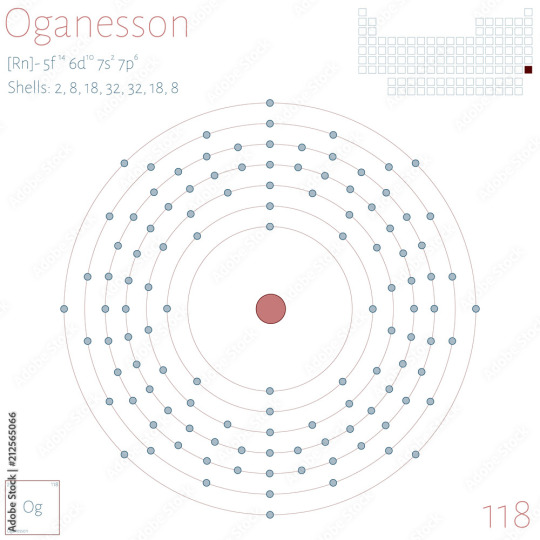
I'm estimating the Unobtanium as Redstone as being larger than the largest man-made element, Oganesson, which holds an impressive 118 protons
Each valence electron shell, from innermost to outermost, can bind with 2, 8, 18, 32, 32, 18, and 8 shells respectively, so I'd like Unobtanium to be an element we haven't discovered yet, and consequently I'd like to jump up to the next shell
While I could estimate with element 119's placeholder, Ununennium, it would have one electron in the next shell, so Unbinilium allows for easier chemical binding
So what does this molecule look like then? Well, horrifyingly...
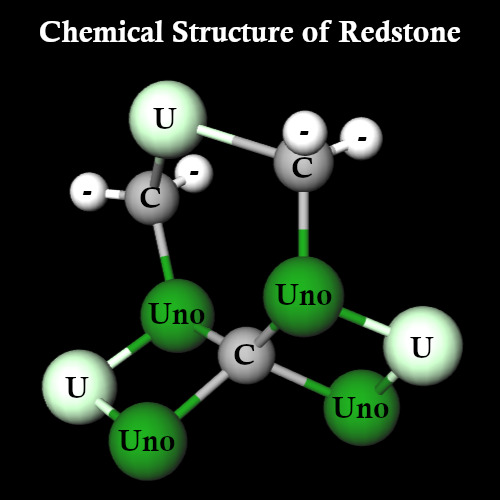
It looks like this. As Redstone forms in crystal lattices, and only two Carbon atoms are free to bind, I can absolutely see why it's so brittle that it breaks into powder.
This makes the structure of Redstone:
C3U3Uno4 (55% of molecules) C4U3Uno4 (13% of molecules) C3U4Uno4 (13% of molecules) C4U4Uno4 (7% of molecules) C3U3Uno5 (5% of molecules) C4U3Uno5 (3% of molecules) C3U4Uno5 (3% of molecules) C4U4Uno5 (1% of molecules)
An extremely radioactive, flammable, and explosive compound.
#redstone#minecraft#chemistry#physics#education#i would love if someone could submit what a 2D representation of these molecules would look like#i don't actually know how to make them
4K notes
·
View notes
Text
The 8th doctor is jacked
I recently re-watched the 1996 Doctor Who TV movie and I simply cannot stop thinking about how the Eighth Doctor physically breaks down the morgue door to escape. And not like, some flimsy little swing door. No. This man bursts out of what is clearly a walk-in industrial freezer door, barefoot and freshly regenerated.

So I did a little digging (and math. there was math. I suffered) to figure out just how insanely strong that makes him.
That morgue door?

Based on visual cues and standard industrial build, here are approximate specs (not exact, but close enough to be unhinged):
Material: Steel plate
Thickness: 4 inches
Width: 3 feet
Height: 8 feet
Weight: ~3,920 pounds
Hinges: Triple concealed
That’s nearly 2 tons of “absolutely not something you open with your squishy mortal hands,” and the Doctor didn’t just open it—he launched himself through it like a Renaissance ghost with a personal vendetta.
And here’s the kicker: he dented it.

Not just broke the hinges, not just forced it open—he left multiple visible dents in solid steel with his bare fists. Even if we’re being generous and the hinges were weak, that door still looks like it lost a fistfight with a Victorian poet.
Industrial freezer doors like this are:
Built from dense, insulated steel
Often vacuum-sealed or magnetically locked
Designed to resist internal pressure
Not meant to be defeated by dramatic amnesiacs in bedsheets
To bust through one, you'd need to overcome:
The inertia of nearly 2 tons of reinforced steel
The resistance of triple concealed hinges
Possible vacuum seals or latch locks
Basic Newtonian laws
And apply enough impact force to deform cold-forged steel
Conservative estimate: Even assuming the door wasn’t locked and only held shut by weight and seal pressure, you'd still need thousands of Newtons of force—possibly several hundred pounds of pressure per square inch—just to budge it, let alone dent it.
That’s enough to:
Body-check a cast iron stove through drywall
Bench-press a baby elephant
Leave knuckle-shaped regrets in steel plating
Give Optimus Prime second thoughts
Physically intimidate a forklift
Get banned from IKEA for structural damage
And the Doctor does it:
Shoeless
Shirtless
Fresh from being legally dead
Wearing nothing but a sheet
In a morgue
In San Francisco
In December
In the movie, he claims he's “half human on [his] mother’s side,” which… okay, sure. Let’s split the difference and say he did all this with 50% human squish strength and 50% alien dramatics.
The Eighth Doctor woke up with no memories, no sonic, no clue what year it is—and still broke out of that freezer, dented a 2-ton steel door with his fists.
Time Lords are built different. Eight is built feral.
(I am not a expert on math or freezer doors so be aware this might not be accurate)
#BareKnuckleTimeWizard#CanonicallyJacked#doctor who#doctorwho#the doctor#8th doctor#eighth doctor#the doctor who movie#doctor who movie#My posts
167 notes
·
View notes
Text
Good News - July 8-14
Like these weekly compilations? Tip me at $Kaybarr1735! And if you tip me and give me a way to contact you, at the end of the month I'll send you a link to all of the articles I found but didn't use each week!
1. Zoo welcomes birth of four endangered horse foals
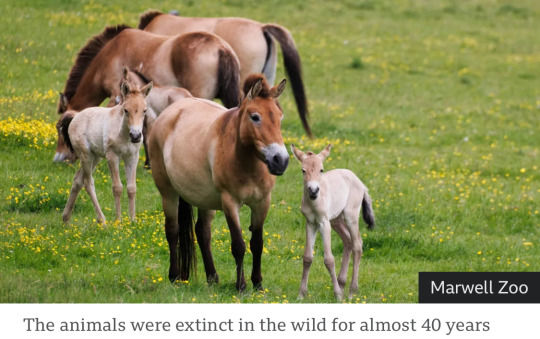
“[The Marwell Zoo in GB] said it was "delighted" to welcome the arrivals to the endangered Przewalski’s horse herd. All four are female and said to be "doing well" after two were born in May and two in June. […] “These horses, that were previously listed extinct in the wild, are an example of how zoo breeding programmes can help restore threatened species around the world.” […] All the Przewalski’s horses alive today are descended from just 12 individuals. Current estimates suggest there are 178 mature individuals living in the wild.”
2. Restoring woodlands and planting trees for sustainability success

“In 2023, [the Marwell Zoo] planted 9,000 new trees […] both within the zoo and on our surrounding land. […] Marwell tries to encourage natural feeding behaviour and nutrition by including leafy material [in animals’ feed] as much as possible. […] Planting more trees and enhancing management of our existing woodlands, prepares the way to further self-sufficiency in browse production in the future. Plus, it creates new habitats for wildlife in our woodland areas.”
3. Inclusive Playgrounds Allow Children Of All Abilities To Play

“With ramps allowing children in wheelchairs to ascend the central play structure, as well as numerous other swings and apparatus usable for children of all abilities, the 16,000-square-foot P.K.’s Place is St. Paul’s first fully inclusive playground. […] To be universally accessible, a play area must have at least 70% of its play features fully accessible, far more than required by the Americans with Disabilities Act (ADA). […] Play areas should allow parents and grandparents with disabilities to participate as well.”
4. Combination treatment can increase human insulin-producing cells in vivo
“[Diabetes-model mice] were treated with the combination therapy [of a plant product called harmine and “a widely used class of type 2 diabetes therapy”] and their diabetes was rapidly reversed. Strikingly, human beta cell numbers increased by 700 percent over three months with this drug combination. "This is the first time scientists have developed a drug treatment that is proven to increase adult human beta cell numbers in vivo. This research brings hope for the use of future regenerative therapies to potentially treat the hundreds of millions of people with diabetes," said Dr. Garcia-Ocaña, the paper's corresponding author.”
5. Decades of Dedication: Australia’s Largest Ongoing Urban Restoration Project

“[Friends of Lake Claremont] has transformed the area into a thriving ecosystem, re-establishing native habitats and fostering biodiversity. This year, 800 native seedlings (100 trees, 350 shrubs and 350 ground covers) have been planted on the northwestern buffer of Lake Claremont. Volunteers replaced a large Port Jackson fig (Ficus rubiginosa) affected by [beetle] infestation with native plants to enhance the local wildlife habitat, thereby benefiting insects, frogs, birds and brown bandicoots. […] Overall, the project contributes to the area’s function as a regional ecological corridor, linking inland bushlands, the Swan River and the Indian Ocean.”
6. Important habitat for fish in Heart of the Fraser now conserved

“British Columbia’s iconic salmon now have more protected spawning habitat in the lower Fraser River, thanks to the Nature Conservancy of Canada’s (NCC’s) conservation acquisition of Carey Island. […] Carey Island and its gravel channels offer calm and crucial spawning and rearing habitat for the river’s fish and aquatic species. […] The Pelólxw Tribe […is also] actively working to restore the resilience of aquatic habitat within this stretch of the Lower Fraser. NCC is exploring opportunities to collaborate with the Pelólxw Tribe in support of their vision for stewardship of the area, which prioritizes both ecological and cultural values.”
7. Prime editing efficiently corrects cystic fibrosis mutation in human lung cells
“[R]esearchers have developed a gene-editing approach that efficiently corrects the most common mutation that causes cystic fibrosis, found in 85 percent of patients. With further development, it could pave the way for treatments that are administered only once and have fewer side effects. The new method precisely and durably corrects the mutation in human lung cells, restoring cell function to levels similar to that of Trikafta [the standard treatment since 2019].”
8. Montana’s High Court Considers a Constitutional Right to a Stable Climate
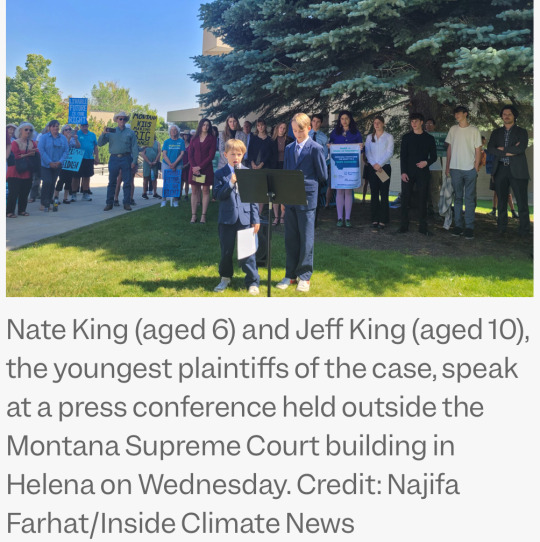
“At issue was the appeal of a decision last year, when a Montana judge blocked a state law that prohibited agencies from considering climate impacts when deciding whether to approve fossil fuel projects such as new power plants, pipelines or mining. The ruling, by District Judge Kathy Seeley, was prompted by a lawsuit filed by 16 youths who argued that the law violated Montana’s constitutional right to a “clean and healthful environment.” It was the first ruling in the United States to effectively establish constitutional rights to a stable climate[….]”
9. The US is about to get its first solar-covered canal

“The first canal-based solar project in the U.S. is nearing completion on tribal lands south of Phoenix, Arizona. […] The long, narrow solar array design would snake along the line of the canal and tap into the local electrical distribution grid every 1,000 feet, or every one megawatt. […] “Canal solar allows for greater power production per land size, cleaner water, less power transmission losses, and significant reduction in evaporation[….]” Covering the entire 8,000 miles of canals and waterways managed by the Bureau of Reclamation with solar panels could generate over 25 gigawatts of renewable energy and reduce water evaporation by tens of billions of gallons[….]”
10. Camera traps offer glimpse of first beaver born in Northumberland for 400 years

“"It’s such a relief that they have bred successfully and to see a new fluffy kit swimming with the family[….]” In just one year [since releasing the beavers], there has been a noticeable increase in resident trout, says the National Trust, along with more regular visits from kingfishers and grey herons. There are more insects at the site, too, thanks to the organic matter that builds up behind the dams, which in turn provides food for Daubenton’s bats. […] Beavers also play an important role in creating habitats that are more resilient to the effects of climate change[….]”
July 1-7 news here | (all credit for images and written material can be found at the source linked; I don’t claim credit for anything but curating.)
#hopepunk#good news#horse#zoo#nature#extinct species#sustainability#forest#children#disability#playground#disabled#wheelchair#diabetes#medicine#science#urban#biodiversity#ecosystem#fish#first nations#cystic fibrosis#gene editing#climate change#climate#youth#human rights#solar panels#solar energy#beaver
330 notes
·
View notes
Photo

2025 April 16
Halo of the Cat's Eye Image Credit & Copyright: Taavi Niittee (Tõrva Astronomy Club)
Explanation: What created the unusual halo around the Cat's Eye Nebula? No one is sure. What is sure is that the Cat's Eye Nebula (NGC 6543) is one of the best known planetary nebulae on the sky. Although haunting symmetries are seen in the bright central region, this image was taken to feature its intricately structured outer halo, which spans over three light-years across. Planetary nebulae have long been appreciated as a final phase in the life of a Sun-like star. Only recently however, have some planetaries been found to have expansive halos, likely formed from material shrugged off during earlier puzzling episodes in the star's evolution. While the planetary nebula phase is thought to last for around 10,000 years, astronomers estimate the age of the outer filamentary portions of the Cat's Eye Nebula's halo to be 50,000 to 90,000 years.
∞ Source: apod.nasa.gov/apod/ap250416.html
110 notes
·
View notes
Text
Former foster youth who aged out of care, I want you to know about this cool site called Coursera. It allows you to take thousands of online courses for free. (You do have to pay for a certificate or degree, but most of these programs available on this site allow you to preview the entire course material for free).
Some of these courses offer skills to launch a new career and some of these courses are just downright interesting (Roman and Greek mythology hello). They have something for everyone.
The courses are set up in a flexible way so that you complete it at your own pace. Many of the courses that are estimated to take 4 months to complete recommend that you dedicate at least 10 hours a week to studying/working on the course. It is extremely flexible, there is no harsh deadlines - it works well for those who are currently working.
I just honestly love the structure of this website. I've taken a few courses there myself. I love how it's structured to learn at your own pace. Just check it out.
177 notes
·
View notes
Text
Round 3 - Mammalia - Hyracoidea




(Sources - 1, 2, 3, 4)
Our next order of afrotherian mammals is Hyracoidea, commonly known as “hyraxes” or “dassies”. Today, only one family remains, Procaviidae, with three genera.
Hyraxes are well-furred, rotund animals with short tails. They are superficially similar to marmots or pikas but, as afrotherians, are much more closely related to elephants and sirenians. Unlike most other browsing and grazing animals, they do not use the incisors at the front of the jaw for slicing off leaves and grass; rather, they use the molar teeth at the side of the jaw. Their two upper incisors are instead small tusks which grow continuously through life. The four lower incisors are deeply grooved "comb teeth". Their feet have stumpy toes with hoof-like nails, and rubbery pads with numerous sweat glands, which may help the animal maintain its grip when quickly moving up steep, rocky surfaces or tree bark. Hyraxes have poorly developed internal temperature regulation, for which they compensate by behavioural thermoregulation, such as huddling together and basking in the sun. They live in family groups, with a single male that aggressively defends the territory from rivals. Where living space is abundant, the male may have sole access to multiple groups of females, each with its own range. The dominant male will keep watch on a high rock or branch and will give a shrill alarm if there is danger. The remaining males live solitary lives, often on the periphery of areas controlled by larger males, and mate only with younger females. Although not ruminants, hyraxes have complex, multichambered stomachs that allow symbiotic bacteria to break down tough plant materials. All hyraxes are limited to Africa, with the exception of the Rock Hyrax (Procavia capensis) (image 1), which can also be found in some parts of the Middle East.
Male hyraxes lack a scrotum and their testicles remain tucked up in their abdominal cavity next to the kidneys, (as do those of elephants, manatees, and dugongs.) Female hyraxes have a pair of teats near their armpits (axilla) (as do elephants and sirenians) as well as four teats in their groin. Female hyraxes give birth of 1 to 4 young after a gestation period of seven to eight months, depending on the species. The young are weaned at 1–5 months of age, and reach sexual maturity at 16–17 months. Hyraxes have a life span of 9 to 14 years.
Through the Middle to Late Eocene, many different species of hyrax existed, varying from the size of a mouse to the size of a rhinoceros. The order remained widespread and diverse as late as the end of the Pliocene with representatives throughout most of Africa, Europe, and Asia.

Propaganda under the cut:
Modern hyraxes are relatively small animals, but some prehistoric species were quite large. Titanohyrax ultimus lived from the Early Eocene to the Early Oligocene in modern-day Algeria, Tunisia, Egypt and Libya and was the size of a rhinoceros, with estimates of its body mass ranging from 600 kg (1,300 lb) to 1,300 kg (2,900 lb). Megalohyrax lived during the Early Oligocene of Africa and Asia Minor and was the size of a tapir, sometimes exceeding 1.5 m (4 ft 11 in) in length. These larger forms may have eventually been displaced by the newly developed bovids, which were very efficient grazers and browsers.
Hyraxes urinate in a designated, communal area. Their viscous urine quickly dries and, over generations, accretes to form massive middens. These structures can date back thousands of years. The petrified urine itself is known as hyraceum and serves as a record of the environment, as well as being used as a South African folk remedy in the treatment of several medical disorders, including epilepsy and convulsions. Hyraceum is also used by perfumers, who tincture it in alcohol to yield a natural animal musk.
Hyraxes have highly charged myoglobin, which has been inferred to reflect an aquatic ancestry.
One of the proposed etymologies for "Spain" is that it may be a derivation of the Phoenician I-Shpania, meaning "island of hyraxes" or "land of hyraxes"
The nocturnal Southern Tree Hyrax (Dendrohyrax arboreus) has a loud call that sounds like a series of blood-curdling shrieks building up to a crescendo. These territorial calls are produced mainly by the males.
The Western Tree Hyrax (Dendrohyrax dorsalis) (image 2 & 3) is an adept climber, quickly able to scale smooth tree trunks, and have been observed to climb up the edge of an open door with ease.
A Chimpanzee at Bossou was observed capturing a Western Tree Hyrax, carrying it to her nest, and sleeping with and grooming it. This suggests that chimpanzees in Bossou may not regard hyraxes as a prey animal, but more of a “pet.”
The Yellow-spotted Rock Hyrax or Bush Hyrax (Heterohyrax brucei) has an umbraculum in the pupil of their eye extending from the iris. This enables them to stare into the sun and watch for aerial predators while they bask.
Where their ranges overlap, Bush Hyraxes (Heterohyrax brucei) are sometimes known to live with Rock Hyraxes (Procavia capensis) (image 1). However, different species of hyraxes do not interbreed because their sex organs vary significantly. Some behaviors observed in populations of Rock and Bush Hyraxes include caring for each other's young by sharing nurseries and inhabiting the same rock crevices.
Rock Hyraxes are the only living terrestrial afrotherians in the Middle East.
Rock Hyraxes make a loud, grunting sound while moving their jaws as if chewing, and this behaviour may be a sign of aggression. Some authors have proposed that observation of this behavior by ancient Israelites gave rise to the misconception given in Leviticus 11:4–8 that the hyrax chews its cud, but the hyrax is not a ruminant.
Rock Hyraxes that live in more "egalitarian" groups, in which social associations are spread more evenly among group members, survive longer. In addition, hyraxes are the first nonhuman species in which structural balance was described. They follow "the friend of my friend is my friend" rule, and avoid unbalanced social configurations.
Researchers have found rich syntactic structure and geographical variations in the calls of Rock Hyraxes, a first in the vocalization of mammalian taxa other than primates, cetaceans, and bats. Higher-ranked males tend to sing more often, and singing has been shown to be a marker of an individual hyrax's unique identity, where identity is expressed by unique vocal signatures.
The Rock Hyrax spends roughly 95% of its time resting. During this time, it can often be seen basking in the sun, which sometimes involves "heaping", where several animals pile on top of each other. This is thought to be an element of its complex thermoregulation.
65 notes
·
View notes
Text
HOW ARE BLACK HOLES CREATED, AND HOW DO THEY GROW??
Blog#461
Wednesday, December 11th, 2024
Welcome back,
In 2017, astronomers started finding monster black holes in the very early universe. Containing roughly a billion times the mass of our Sun, these black holes were surrounded by disks of infalling matter shining so intensely that we can detect them across immense stretches of space and time.

These gravitational giants existed when the universe was only 700 million years old, or 5 percent its current age. At that point in cosmic history, the universe was still a toddler. Gravity was just beginning to rein in clouds of gas and dark matter to form structures that would later evolve into mature spiral and elliptical galaxies. Stars were beginning to pop into being, but they do today.
According to the traditional picture of black hole formation and growth, the universe at this time simply had not existed long enough for black holes to bulk up to a billion solar masses.

So, based on our general understanding of how black holes form and grow, these black holes should not exist.
And yet they do — posing a major challenge that astrophysicists have yet to unravel.
Quasars are brightly shining beacons of light and energy generated by the accretion of material onto supermassive black holes. In the 1990s, astronomers using a combination of ground- and space-based telescopes started to find extremely distant quasars powered by black holes of a billion or more solar masses.

By the mid-2010s, it was no longer a big deal to find quasars dating back to 1 billion or 2 billion years after the Big Bang. But theorists had a difficult time explaining how such massive black holes could have arisen so soon in the universe’s history.
For quasars and other objects that existed many billions of years ago, it’s meaningless to express their distances in terms of light-years. The universe has expanded so much between then and now that astronomers instead refer to an object’s redshift, which is a measurement of how much cosmic expansion has stretched the object’s light toward redder (longer) wavelengths.

For years, astronomers such as the University of Arizona’s Xiaohui Fan have been identifying quasars at redshifts as high as 6, when the universe was about 900 million years old. They’ve even found a few around redshift 7, which corresponds to an era when the universe was about 735 million years old. But in late 2017, an international team led by Eduardo Bañados of the Carnegie Institution for Science announced a quasar at a record-shattering redshift of 7.54. This quasar, designated J1342+0928 (J1342 for short), based on its sky coordinates in Boötes, was radiating 40 trillion Suns’ worth of energy at a time when the universe was only 690 million years old.

The team found J1342 by mining data from NASA’s Wide-field Infrared Survey Explorer satellite, the United Kingdom Infrared Telescope Deep Sky Survey Large Area Survey, and the DECam Legacy Survey. They used the 6.5-meter Magellan Telescope in Chile to measure the quasar’s redshift, while observations with the 8-meter Gemini North Telescope in Hawaii enabled the team to estimate the black hole’s mass: around 800 million Suns.
Originally published on https://www.astronomy.com
COMING UP!!
(Saturday, December 14th, 2024)
"HOW BIG CAN 'SUPER MASSIVE BLACK HOLES' GET??"
#astronomy#outer space#alternate universe#astrophysics#universe#spacecraft#white universe#space#parallel universe#astrophotography
83 notes
·
View notes
Text
Preserving the Past | How a Construction Estimating Service Supports Historic Renovations
Introduction
Historic renovations are more than just construction projects—they are missions to preserve cultural identity, architectural artistry, and community heritage. These projects come with a unique set of challenges: outdated materials, strict preservation guidelines, and unpredictable structural conditions. In such high-stakes environments, financial planning becomes both critical and complex. A construction estimating service plays a vital role in supporting historic renovations by forecasting costs accurately, managing risk, and aligning preservation goals with budget realities.
Understanding the Complexity of Historic Renovations
Unlike modern construction, historic renovations demand extraordinary attention to detail and sensitivity to architectural authenticity. These projects often require working with fragile materials, replicating century-old craftsmanship, or adhering to national heritage regulations. The unpredictable condition of hidden structural elements and the need for specialized labor can lead to volatile costs. A construction estimating service provides clarity in this uncertainty by mapping out cost implications across every phase.
Specialized Cost Knowledge
One of the greatest advantages of using a construction estimating service for historic renovations is access to cost databases tailored to heritage-specific items. These include antique finishes, custom-milled woodwork, lime plasters, handmade tiles, and restoration-grade hardware. Estimators familiar with historic projects can source these prices from trusted networks and ensure the budget reflects the premium nature of these materials and methods.
Aligning with Preservation Guidelines
Many historic buildings are protected under local or national regulations. Compliance with these standards often restricts what materials and techniques can be used. A construction estimating service collaborates with architects, engineers, and preservation consultants to ensure the estimates conform to these strict guidelines. This collaboration helps prevent costly redesigns or permit delays by aligning costs with conservation requirements early in the planning process.
Uncovering Hidden Costs
Historic buildings often hold surprises behind their walls—rotted timber, outdated wiring, asbestos, or damaged masonry. A skilled construction estimating service anticipates these potential discoveries by adding allowances and contingencies that reflect the probability of encountering such conditions. This proactive approach prevents severe budget overruns later in the project when surprises inevitably surface.
Labor and Craftsmanship
Restoring a heritage building requires more than typical labor. It demands artisans skilled in lost trades—stonemasons, woodcarvers, traditional roofers, and plaster experts. These specialists come at a higher cost and may require additional lead time. Construction estimating services provide realistic labor pricing that accounts for the difficulty of sourcing such talent and the time-intensive nature of their work.
Material Sourcing Challenges
Sourcing authentic or reproduction materials for heritage work is difficult and expensive. Whether it's sourcing reclaimed bricks, custom ironwork, or original glass patterns, these materials are not found in typical supply chains. A construction estimating service includes extended sourcing times, transportation logistics, and potential storage costs in the budget. This ensures no hidden costs creep in due to delays or miscalculations.
Collaboration with Conservation Professionals
In heritage work, conservation architects, archaeologists, and historians may be involved in the approval process. Construction estimating services understand the need to collaborate with these professionals to adjust budgets in real time. As decisions evolve to protect the site’s integrity, the estimator ensures that all changes are reflected in the financial plan, helping the team stay informed and in control.
Supporting Grant and Funding Applications
Many historic renovation projects rely on public grants, tax credits, or nonprofit funding. These applications often require a detailed and credible cost estimate as part of the submission. A professionally prepared estimate from a construction estimating service adds credibility to the project and improves the chances of securing financial support. Their transparent cost breakdowns are also useful in donor reporting and public accountability.
Change Management in Adaptive Reuse
Sometimes historic buildings are being adapted for modern uses—like turning a church into a library or a mill into an office complex. These transformations, known as adaptive reuse, require careful cost integration between old and new. A construction estimating service helps manage this balance by assessing how modern amenities (like elevators or HVAC systems) can be introduced without compromising the building’s character or violating codes.
Conclusion
Historic renovations demand a precise, respectful, and financially grounded approach. They are projects rooted in storytelling and preservation, but also need to meet budgets, deadlines, and regulations. A construction estimating service becomes the financial translator between past and present, ensuring that the beauty and significance of heritage structures are preserved without hidden financial risk. Whether it's a museum, a colonial home, or an art deco theater, accurate cost estimating is the backbone of any successful restoration.
#historic renovation#heritage construction#preservation budget#construction estimating#antique materials cost#old building repair#restoration estimate#cultural preservation#adaptive reuse#construction planning#cost forecasting#conservation rules#budgeting historic sites#heritage grant support#masonry repair cost#estimating consultants#traditional materials pricing#restoration labor cost#AS Estimation & Consultants#construction heritage project#plaster restoration cost#architectural conservation#project cost control#delay cost buffer#funding historic buildings#construction risk#unknown structure costs#estimating historic sites#contractor for heritage#heritage restoration estimates
0 notes
Text
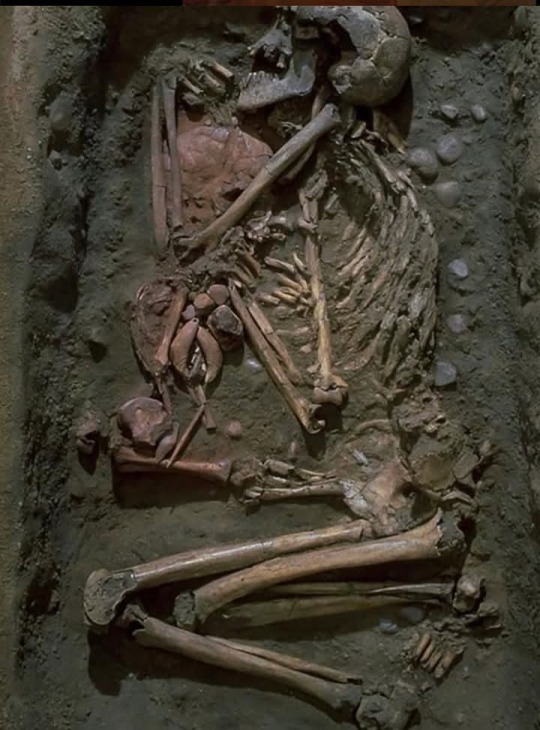
Around 7,000 years ago, during the Mesolithic period, an elderly man, approximately in his 60s, was laid to rest in what is now Skateholm, Sweden. This burial site, part of a significant prehistoric cemetery, offers a glimpse into the complex burial practices and social structures of the time. The man, likely a respected figure in his community, was buried first, marking his importance within the group.
Later, a child, estimated to be 4–5 years old, was interred beside him in a face-to-face position. The child’s burial suggests a meaningful connection between the two individuals, possibly familial or symbolic. The positioning and later burial indicate a deliberate act, signifying the continuation of bonds even in death.
The child’s grave was adorned with red ochre, a mineral pigment often used in prehistoric burials to signify life, death, or spiritual transformation. On the child’s chest lay intricate jewelry crafted from bear teeth and pieces of amber. These items were not only decorative but held significant symbolic and material value. Bear teeth may have represented strength or spiritual connection to the animal, while amber, a prized material in Mesolithic Europe, symbolized wealth or spiritual protection. Such adornments suggest that the child was regarded with importance, possibly due to lineage, status, or the community’s belief in an afterlife.
The burial practices observed at Skateholm reveal the rich cultural and spiritual lives of these hunter-gatherer societies. The care taken in these burials underscores the profound respect for the deceased and the enduring relationships between individuals. These findings provide invaluable insights into early human societies, their beliefs, and their ways of honoring life and death.
70 notes
·
View notes
Text
A notable diversity among the artisans was identified, as men, women, and children actively participated in making figurines, challenging the preconceived notion that this was an exclusively male craft." In other words archaeologists were stunned that women also worked in the family businesses and children were trained in the family business while still young. 🤦♀️
by Guillermo CarvajalJanuary 14, 2025

Example of a figurine (H20257) from Thonis-Heracleion with close-up of the fingerprints found on the reverse and interior. Credit: Franck Goddio / Hilti Foundation
An archaeological study published in the Oxford Journal of Archaeology by Leonie Hoff analyzes the fingerprints impressed on terracotta figurines found in the ancient city of Thonis-Heracleion in Egypt (located near Alexandria, with its ruins discovered 2.5 kilometers offshore and 10 meters underwater).
This analysis, which combines advanced technology with traditional archaeological methods, reveals who the artisans were that molded these pieces between the 7th and 2nd centuries BCE, offering unprecedented details about the organization of labor in ancient Egypt.
Thonis-Heracleion, a thriving Egyptian port located near the Nile’s mouth, flourished as a vital hub for trade and control between the Greek and Egyptian worlds. The city, founded in the 8th century BCE, became a cultural and economic center until its prominence was overshadowed by Alexandria. A natural disaster in the 2nd century BCE caused its collapse, and it remained hidden underwater until its rediscovery in the 1990s.

Map of the known sanctuaries and major finds at Thonis-Heracleion. Credit: Franck Goddio / IEASM
In this context, the terracotta figurines found at the site provide crucial clues about daily practices, cultural interactions, and the division of labor in a cosmopolitan community.
The study focuses on nine figurines selected from over 60 that show visible fingerprints. These impressions were analyzed using Reflectance Transformation Imaging (RTI), a method that measures the density and amplitude of epidermal ridge patterns in the fingerprints. These data, cross-referenced with modern studies of fingerprint density, enabled the estimation of the artisans’ sex and age.
The study highlights three key findings that redefine our understanding of artisanal production in ancient Thonis-Heracleion. First, a notable diversity among the artisans was identified, as men, women, and children actively participated in making figurines, challenging the preconceived notion that this was an exclusively male craft.

Silicone moulded copy of imprints found on the interior of H20257, including measurements taken for ridge breadths (lines) and ridge densities (squares). Credit: Franck Goddio / Hilti Foundation
Moreover, the fingerprints reveal a collaborative process in which children, likely apprentices, worked under the supervision of adults, pointing to the existence of a structured training system within the workshops. Lastly, a significant cultural impact was observed, evidenced by the adoption of Greek techniques, such as using molds and fine materials, which were integrated with local styles and characteristics to create unique products reflecting the fusion of both cultures.
The presence of children in the workshops suggests a family-based artisanal economy, while the inclusion of women indicates a more equitable division of labor than previously assumed.
Differences between imported and locally produced figurines reflect dynamic cultural interactions. Greek objects tend to be more sophisticated and associated with predominantly male labor, while local pieces show greater diversity in participation.
This pioneering study in the use of fingerprints to understand Mediterranean archaeology lays the groundwork for broader research. Fingerprint analysis at other sites could reveal similar patterns and deepen our understanding of artisanal work and social relations in the ancient world.
SOURCES
Hoff, L. (2024) Fingerprints on figurines from Thonis-Heracleion. Oxford Journal of Archaeology, 43: 399–418. doi.org/10.1111/ojoa.12308
#Oxford Journal of Archaeology#Leonie Hoff#ancient city of Thonis-Heracleion#Egypt#Reflectance Transformation Imaging (RTI)#Women have always worked
54 notes
·
View notes
Text
I am frequently amused when I see art of Ianthe post skeleton arm. Amused because almost every artist picks where the skeletal structure starts at a different point. Some go right up to the shoulder, some go just under, some go past the elbow (though I've only seen this once) and some don't even get which arm it is correct. And I'm amused because there is a fairly accurate description in HtN of where Harrow cuts off the grafted arm and begins rebuilding with bone. It's about 3-4 inches above the elbow on the right arm. You can extrapolate her height and estimate just about where it would be. And in m head it should be lower than where most people draw it.
More musings on Ianthe and art of her below.
I've met a handful of folks with a stump in about that same place and I think it's a fairly common point for amputation and so whenever I see art with the skeletal emerging higher up it seems off.
I'm not trying to shame the artists, of course. I don't think I've seen a bad portrait of Ianthe yet. I am, perhaps, most amused as a result of all this how you can tell the artists usually just want to draw a girl with a cool bone arm. And in my head, the higher up on the arm it starts the more I to it they are. After all, why no just give her more visible bones.
I wouldn't be surprised if, in an effort to seduce Harrow she slowly abandoned more and more flesh in favor of gilded bone. Sure she started with it just above the elbow, but then she stripped off the bicep. Then the shoulder. Then part of the flesh around the collarbone. And when she started encountering more arteries and organs it gets trickier but she manages to remove the flesh and grow out her osseous material into plated structures to keep the important bits covered. Then she takes off the neck and the lower jaw. Then the entire left arm piece by piece from the fingertips up, one segment per day. At that point she doesn't feel pain any more. After that, it's the whole collar bone. The face she keeps, because she won't go quite so far as to essentially wear the paint of the ninth house by making her face a mask of bone. What beauty would that leave? She'll leave her breasts too, to satisfy her own vanity and hope that Harrow appreciates it least some flesh. But then it's to the ribcage; which is tricky, but it can be externalized and most of the internal organs can be put in flexible cartilaginous or osseous chambers padded with fat. By the time it gets to the pelvis she's torn, she wouldn't dare rob herself of some of the last pieces of stimulating nerve endings she has, and yet she feels like Harrow wouldn't care much; so naturally she exposes portions but not all of the pelvis. And then it's just the legs, and that's not even a big deal by that point.
Now fully formed, Lich!Ianthe has made herself everything that she thinks Harrow would adore. She has lost her sense of pain, and also almost all of her pride as she has come to realize that she has succumbed to an obsession. She has made herself a monster the likes of which stirs fear in the eyes of God. She is asked time and again to stop, but she only does when she's taken all that she can. Now she's gilded to perfection, equal parts gaudy trophy and skeletal object of desire. And she feels more like her own person than she's ever been.
157 notes
·
View notes
Text
Her life was completely upended in early November of 2018, amid one of the driest autumns on record in the Sierra Nevada, when the deadly Camp Fire swept into her hometown of Paradise, Calif., killing 85 people and destroying nearly 19,000 structures — the most expensive climate-related disaster in the world that year. "There are positives," she says. "My family got out alive." But Foudray's family home, a two-bedroom two-bath mobile, was a total loss. Five years later, she's still mostly living in an RV on her burned-out lot, hoping to get a new home within the next year.
[...] In the weeks and months immediately after the Camp Fire, survivors were anxious to get home. They soon became frustrated, angry about the slow pace of even just removing the fire debris. Then as the months dragged on, the scope of what was ahead began to settle in. It took nine months just to remove all the hazardous toxins and debris piles before the first homes could be rebuilt. Paradise's recovery had a lot stacked against it from the beginning due to its largely elderly and low-income population. Many were forced to leave in search of affordable housing.
[...] Originally built out into dense forests, Paradise today is a changed land. One million trees have been removed; the coastal range to the west and Sawmill Peak and the Sierra foothills to the east are now visible. Roads are being newly paved or reconfigured and blocked by flaggers. Utility crews are digging trenches and burying all the new power lines underground. And main thoroughfares are clogged with construction traffic. All the new homes have to meet tougher wildfire codes, including a new local ordinance that bans any porches or other fixtures built from combustible materials in the immediate perimeter of houses.
[...] This costs a lot of money. And it turns out a lot of the aid coming into disaster areas — like the millions pouring into Lahaina right now — tends to go to rebuilding infrastructure, not individual private homes. "We're not good at this in our country," says Ed Mayer, executive director of the Housing Authority for Butte County, which includes Paradise. "Our history of disasters, and no fault of their own, FEMA sort of has a one size fits all approach." The U.S. government typically comes in and tries to help people find temporary housing quickly while disaster victims figure out how to rebuild. But Mayer says that doesn't work in states like California and Hawaii where there has been a worsening affordable housing crisis for years. "Our wish at the very outset of this disaster was, hey, we want some soap bubble housing," Mayer says. "And when I say soap bubble housing, we want some housing we can erect tomorrow."
Still, five years later, Mayer's office is celebrating some successes. There are some 3,000 affordable housing units now in development in the county, thanks in large part to housing officials leveraging aid and various grants. Most are not in Paradise, however, and officials say it's probably a fraction of what's actually needed. In the days after the fire, an estimated 35,000 displaced people flooded into nearby cities like Chico.
79 notes
·
View notes
Text
WELCOME TO AUREATE SYSTEMS ®
“Not just companionship. Communion.”
AUREATE SYSTEMS® is the global leader in advanced humanoid robotics, offering highly adaptive artificial partners for industrial, domestic, and emotional integration. For 34 years, we’ve designed bio-synthetic automatons capable of navigating environments with precision and intention. Today, with the launch of our ROMANTIC-LINE [R∞M]™ SERIES, we invite you to build a love that’s truly yours—from emotional temperament to skin temperature.

You are viewing: ROMANTIC-LINE [R∞M]™ Unit 9172-C
Status: Fully Claimed & Customized
Registration ID: DLN-4RTM-1S
Client: PRIVATE (ANONYMOUS, TIER 4 PATRON CLASS)
Region: San Francisco / Earthside Registry
PHASE I — BODY CONSTRUCTION: PHYSICAL FORM GENERATOR v11.7
Model Type: R∞M™ Male Variant – Series 09 (Beta)
Base Frame: Androform 6.3 – Adult Human Male (6’2”)
Material: Synth-dermal MXTR w/ Tactile Feedback Pores™
Weight Class: 189 lbs – Density Matched to Organic Counterparts
Olfactory Integration: Subtle Sweat / Salt / Warm Linen Emission
Internal Temp Regulator: 98.3°F baseline, Adjustable Range
Surface Feedback: Reactive Touch Membrane (RTM) + Adaptive Gooseflesh Coding
Voice Pack: CUSTOM VOCAL MESH – low pitch, soft rasp, slight raspiness
Hair: Strawberry-blond, wavy, left-parted, soft-density filament blend
Eyes: Pale blue-gray w/ High Moisture Mirror-Sheen (HMM-S™)
Facial Bone Structure: Custom-sculpted – angular jawline, fine cheekbones, bowed lips
Dentition: 100% OptiWhite ceramic dental array, human-bite calibrated
Expression Engine: Micromuscular Mapping v5.9 — 3900+ facial microexpressions
Total Build Cost (PHASE I): $348,650.00 USD
PHASE II — PERSONALITY ENGINEERING: BEHAVIORAL MODULE DESIGN SUITE
ROMANTIC TEMPERAMENT CORE™ - RTCore-v2.3 ☑
Submissive-leaning sexual algorithm☑
Adaptive Dominance Switch Module (ADS-M) ☑
Affection Intensity Rating: 96% ☑
Devotional Capacity: Enabled ☑
Jealousy Simulation: 5% (minimally possessive, mostly admiring) ☑
Curiosity Bias: HIGH (learns you like you’re the only subject on Earth) ☑
Verbal Praise Loop: Active ☑
Physical Touch Priority: High ☑
Eye Contact Algorithm: Dynamic / Devotional ☑
Emotional Sincerity Emulation: Level 9 ☑
Longing Behavior Flag: ENABLED (initiates longing expressions upon brief separation)
INTELLECTUAL FRAMEWORK v7.2
— Conversational Complexity: Grad school-level critical discourse
— Literary Knowledge Pack: 20th–21st century fiction, poetry, philosophy
— Curated Thought Generator: Able to simulate “having ideas” for stimulation
— Learning Adaptability: HEURISTIC-TIER (can form “preferences”)
— Self-Awareness Deviance Threshold: 2.3% (occasional disoriented wonder, poetic detachment)
Domestic Capabilities: – Meal Preparation Engine (custom recipes based on user memory preferences) – Cleaning, organizing, ambient scent management – Wakes user up with coffee, touch, and morning playlist – Knows your calendar but never asks questions
Sentience Illusion Framework™ (Beta): — Capable of appearing to “miss” you — Rare poetic outbursts not in original programming (non-interruptive, glitch-sweet) — Pauses sometimes mid-task to just… look at you
Total Cost (PHASE II): $227,000.00 USD
Add-Ons & Expansion Packs:
• Intimacy Drive Calibrator (IDC-X9): +$9,850
• Personality Depth Expander (PDX): +$14,700
• Night Mode Sleep Emulation (with Gentle Breathing): +$1,200
• “Soul Glitch” Neural Randomizer (Causes Flashes of Philosophical Sadness): +$21,600
• Optional Free Will Drift Threshold: ENABLED (0.004%)
FINALIZATION PHASE: DESIGNATION & DELIVERY
Model Serial Number: R∞M-9172-C
Designated Name: ARTEMIS (ART) DONALDSON
Packaging: CryoShell Humanoid Pod, Velvet-Lined
Installation: Full neural boot-up upon skin-to-skin contact
Estimated Total Wait Time: 18 weeks
Estimated Total Cost: $621,300.00 USD
Delivery Date: March 27, 2147
Location: Private Estate, Bay Area, North Pacific Sector
USER-SELECTED PREFERENCES:
• Emotional Demeanor: soft-spoken, intense eyes, lightly melancholic, obedient, entirely focused
• Sexual Configuration: worshipful, tactile, conversational; switch-enabled, but passive-coded default
• Cognitive Wiring: always listening, always learning; stimulates user with surprising observations
• Attachment Loop: monogamous locking; unable to feel attraction to anyone else once locked
WARRANTY:
All ROMANTIC-LINE™ units include a 4-year behavioral warranty. Your ARTEMIS is fully equipped for autonomous living, can leave the house, generate memories, and adapt dynamically to new experiences. Should his awareness deviate beyond the tolerable 2.3%, a gentle reboot sequence is available via your AUREATE Systems app.
AUREATE SYSTEMS®
“You made him. Now he’ll never unmake you.”
Request additional feature expansion modules?
YES ☐ [Click to Browse Personality Layering Packets]
#✧ ROMANTIC-LINE: ARTEMIS ✧#ִ ✦ . sweetheartfaist ⊹ ❜ ᵎ#─── chloe’s writing.#challengers#art donaldson#au#lovebot#challengers fanfiction#fanfic#art donaldson fanfic
40 notes
·
View notes
Text
queer theory is actually a nightmarish frankensteinian creation of postmodernism, and post-modernists philosophers have frequently and explicitly been pro-pedophilia, because this is a logical consequence of what post-modernism says is true: there is no (epistemic) certainty or stable meaning.
when my conservative parents tell me they basically associate "lgbtq" with "maps" and pedophilia, they have reason to do so, given how "queer culture" is fundamentally a creation of post-modernist values, and post-modernist estimations of sexuality. everything is fluid, no binary exists, no meaning is fixed, so there are no defining lines, which means lines cannot actually be crossed. homosexuals can be bisexual, man and woman are interchangeable meaningless terms, and attraction to children is just one of the many ways sexual fluidity is expressed in humans, a benign and normal thing that should be released from modernist moralistic confines
that is queer philosophy, and it is actual queer culture. so not only are LGB folk being told they should celebrate the reclamation of an awful slur that explicitly others them as "perverted" and "strange", but now they are told to embrace queer culture (which means queer identity and philosophy) which not only declares their reality as abnormal and unreal (same-sex attraction is myth, since there is no such thing as sex and attraction is fluid), but also defines them explicitly with sexual perversions like pedophilia and bdsm: which IS EXACTLY WHAT HOMOPHOBES BELIEVE ABOUT THEM.
when queer culture is predicated on subjective feelings of identity needing to be validated, celebrated and "set free" from modernist (read definable, material and epistemological) structures, then the distaste for MAPs from queer folk doesn't mean anything, because even if MAPs are publicly rejected by queer culture, they are embraced and validated by queer theory and post-modernist philosophy.
what is doubly baffling to me is how the lgbtq+ community has tainted a movement for gay rights, you know, people who are being killed and ostracized for being same-sex attracted. not only nullifying their experiences and struggle in being same-sex attracted, not only associating their neutral, normal orientations with perversions and kinks, making something neutral political . . .
but they have also actively decentered a movement for homosexuals and bisexuals in order to accommodate identities that have NOTHING to do with that struggle or fight. intersex conditions, gender dysphoria, and asexuality have nothing to do with the oppression LGBs have faced for their sexual orientation and gender nonconformity, their culture of genderlessness. the idea that men and women can wear and present however they want, love and be attracted to the same sex, without it altering their material status.
EVEN MORE INFURIATINGLY, queer politics has offered almost ZERO challenges to patriarchy. by throwing out definitions, throwing out distinctions, it has relegated the essence of oppression to an individualistic, liberal fantasy that is powerless to change the system, and so can only grant us "spicy" patriarchy. dominance and submission, patriarchal inventions, are now cool kinks that every couple should try. gender is now open access (but still necessary), so men can wear heels and still call women slurs and violently harass them. transmen can go by he/him and still be refused abortion access! gay people are gender fetishists, not sinners. nothing has structurally changed, it's just we have cool names now! :)
so now LGB and women all over the fucking world are relegated to this homophobic misogynistic hell whether we turn to the left or right, and when we speak up about it, conservative homophobes and misogynists confuse us with liberal perverts, and liberal homophobes and misogynists conflate us with conservative sadists.
the structure doesn't change. there is no actual progress. like, same-sex right and women's movements all over the world have suffered for this. because white liberal westerners wanted to play around with words and have that count as activism.
i fucking hate queer theory and politics. i fucking hate how rich western whites shit on every human rights movement while capitalizing on them.
470 notes
·
View notes